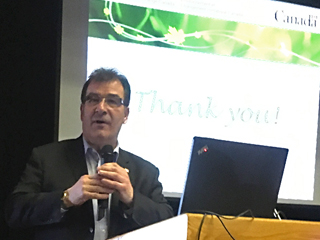 The Honourable Robert Nault, Member of Parliament for Kenora addresses audience at International Rainy-Lake of the Woods Watershed ForumIt was standing room only at the 14th annual International Rainy-Lake of the Woods Watershed Forum, held March 8-9 in International Falls, Minnesota. The record attendance of 162 researchers and policy makers reflects the increasing focus on Lake of the Woods and the Rainy River basin by our governments, the International Joint Commission and stakeholders.
The Honourable Robert Nault, Member of Parliament for Kenora addresses audience at International Rainy-Lake of the Woods Watershed ForumIt was standing room only at the 14th annual International Rainy-Lake of the Woods Watershed Forum, held March 8-9 in International Falls, Minnesota. The record attendance of 162 researchers and policy makers reflects the increasing focus on Lake of the Woods and the Rainy River basin by our governments, the International Joint Commission and stakeholders.
In addition to research studies, this year’s Forum featured significant participation of elected officials – an important indication of their interest and support for the research and for the policy efforts underway to put a binational plan in place for the Lake of the Woods basin. Participation included an address by the Rt. Honourable Robert Nault, Member of Parliament for Kenora, a video address by U.S. Senator Al Franken, as well as attendance of officials representing Senator Franken, U.S. Senator Amy Klobuchar and U.S. Congressman Rick Nolan.
Felicia Minotti of Global Affairs Canada, presented an outline of how Canada and the United States propose to integrate the Canadian and American science into an overall binational framework for moving for moving forward with remedial actions. The results for Lake of the Woods should be the establishment of international water quality objectives and reduction targets for nutrient pollution and identification of management actions needed to combat the blooms of harmful blue green algae that plague Lake of the Woods each summer.
The proposed framework for action relies heavily on the binational framework that we’ve been working to put in place for over a decade – with science coordination managed by the International Multi-Agency Arrangement collaboration of local agencies, working closely with the International Joint Commission and its Rainy-Lake of the Woods Watershed Board, to develop water quality objectives and policy recommendations to governments. The IJC would have an additional role, to provide oversight assessment and reporting on scientific progress and progress towards achievements of lake objectives, much like it does on the Great Lakes.
